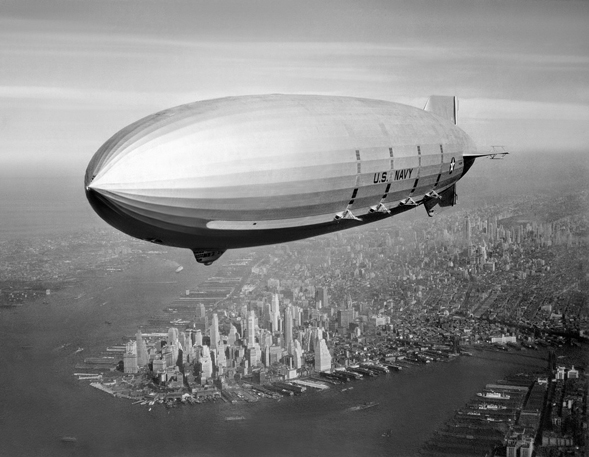



USS Macon (ZRS-5) was a rigid airship built and operated by the United States Navy for scouting and served as a "flying aircraft carrier", carrying up to five single-seat Curtiss F9C Sparrowhawk parasite biplanes for scouting or two-seat Fleet N2Y-1s for training. In service for less than two years, the Macon was damaged in a storm and lost off California's Big Sur coast in February 1935, though most of the crew were saved. The wreckage is listed as the USS Macon Airship Remains on the U.S. National Register of Historic Places.
Less than 20 ft. (6.1 m) shorter than the Hindenburg, both Macon and her sister ship Akron were among the largest flying objects in the world in terms of length and volume. Although the hydrogen-filled, Zeppelin-built Hindenburg and LZ 130 Graf Zeppelin II were both longer, the two American-built naval airships still hold the world record for largest helium-filled rigid airships.
Construction:
USS Macon was built at the Goodyear Airdock in Springfield Township, Ohio, by the Goodyear-Zeppelin Corporation at a cost of $2.45 million (equivalent to $53 million in 2022) under a fixed-price contract. Because this was by far the biggest airship ever to be built in America, a team of experienced German airship engineers led by Chief Designer Karl Arnstein instructed and supported design and construction of both the U.S. Navy airships Akron and Macon.
Macon had a structured duraluminum hull with three interior keels. The airship was kept aloft by 12 helium-filled gas cells made from gelatin-latex fabric. Inside the hull, the ship had eight German-made Maybach VL II 12-cylinder, 560 hp gasoline-powered engines that drove outside propellers. The propellers could be rotated down or backwards, providing an early form of thrust vectoring to control the ship during takeoff and landings. The rows of slots in the hull above each engine were part of a system to condense out the water vapor from the engine exhaust gases for use as buoyancy compensation ballast to compensate for the loss of weight as fuel was consumed.
Christening and Commissioning:
Macon was christened on 11 March 1933, by Jeanette Whitton Moffett, wife of Rear Admiral William A. Moffett, Chief of the U.S. Navy's Bureau of Aeronautics. The airship was named after the city of Macon, Georgia, which was the largest city in the Congressional district of Carl Vinson, then the chairman of the U.S. House of Representatives' Committee on Naval Affairs. Macon was commissioned into the U.S. Navy on 23 June 1933, with Commander Alger H. Dresel in command.
On 24 June 1933, Macon left Goodyear's field for Naval Air Station (NAS) Lakehurst, New Jersey, where the new airship was based for the summer while undergoing a series of training flights. The airship left the East Coast on 12 October 1933, on a transcontinental flight to her new permanent home base at NAS Sunnyvale (now Moffett Federal Airfield, named after Admiral Moffett who was killed when the USS Akron crashed) near San Francisco in Santa Clara County, California.
Crash:
On 12 February 1935, the repair process from damage sustained on a previous flight was still incomplete when, returning to NAS Sunnyvale from fleet maneuvers, Macon ran into a storm off Point Sur, California. During the storm, the ship was caught in a wind shear which caused structural failure of the unstrengthened ring (17.5) to which the upper tailfin was attached. The fin failed to the side and was carried away. Pieces of structure punctured the rear gas cells and caused gas leakage. The commander, acting rapidly and on fragmentary information, ordered an immediate and massive discharge of ballast. Control was lost and, tail heavy and with engines running full speed ahead, Macon rose past the pressure height of 2,800 ft. (850 m), and kept rising until enough helium was vented to cancel the lift, reaching an altitude of 4,850 ft. (1,480 m). The last SOS call from Commander Wiley stated "Will abandon ship as soon as we land on the water somewhere 20 miles off of Pt. Sur, probably 10 miles at sea." It took 20 minutes to descend and, settling gently into the sea, Macon sank off Monterey Bay.
Only two Macon crew members were lost thanks to the warm conditions and the introduction of life jackets and inflatable rafts after lessons learned from the Akron tragedy. There were only three survivors and 73 died when the Akron crashed during a storm in the Atlantic Ocean on April 3, 1933. The Akron crew had not been issued life jackets and there had not been time to deploy a single inflatable raft. The crashes of the Macon and Akron ended the U.S. Navy’s experiment of using dirigibles as aircraft carriers.
Facts and General Characteristics of the USS Macon:
Manufacturer: Goodyear-Zeppelin Corporation
Registration: ZRS-5
Constructed: 1929-1931
Crew: 60
Length: 785 ft. (239.3 m)
Diameter: 133 ft. (40.5 m)
Volume: 7,401,260 cu ft. (209,580.3 m3)
Powerplant: 8 x Maybach VL II 12-cyl water-cooled fuel-injected V-12 engines producing 560 hp each.
Maximum Speed: 75 knots (139 km/h; 86 mph)
Range: 6,840 mi (11,000 km at 10 knots (19 km/h; 12 mph)
Armament: 8 x .30-cal machine guns
Aircraft Carried: 5 x Curtiss F9C Sparrowhawk or 2 x Fleet N2Y-1 or Waco XJW-1
Facts and General Characteristics of the Model:
The model could be built as either the USS Macon or the USS Akron. Both airships were nearly identical with a few different parts such as the hood vents, propeller shafts and radiators. Decals were included for either airship. It came with a base but I custom built a base.
Manufacturer: AMT Corporation, Troy, Michigan
Scale: 1/520
Length: 17.8”
Diameter: 3”
Parts used: 54
Decals: 9
Hours to build and paint: 12.0
Problems/mistakes:
1. This is a very old model kit that has been out of production for several years (I purchased it on an online auction), so some of the decals broke apart.
2. The parts were not numbered, and the parts for the Macon and Akron were only slightly different.
3. The rudder assists and their struts are too thick.
4. The vertical fin strut braces were too thick so I used wire instead. They’re still too thick as you can barely see them in photos of the actual airship.
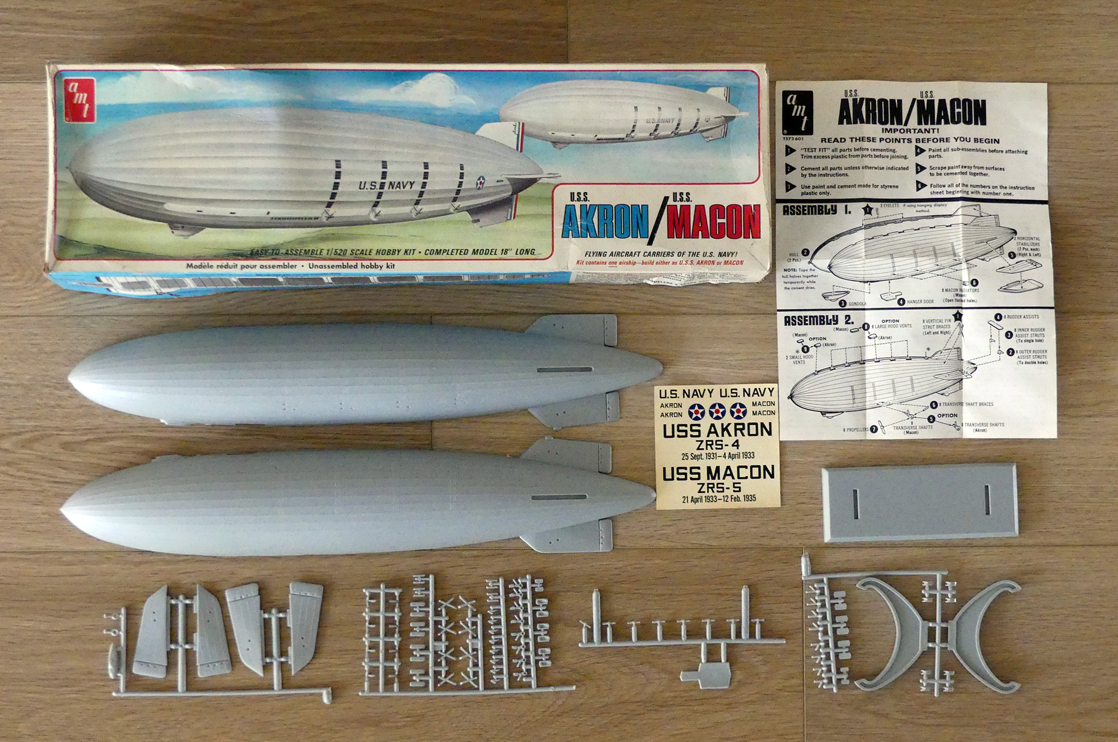
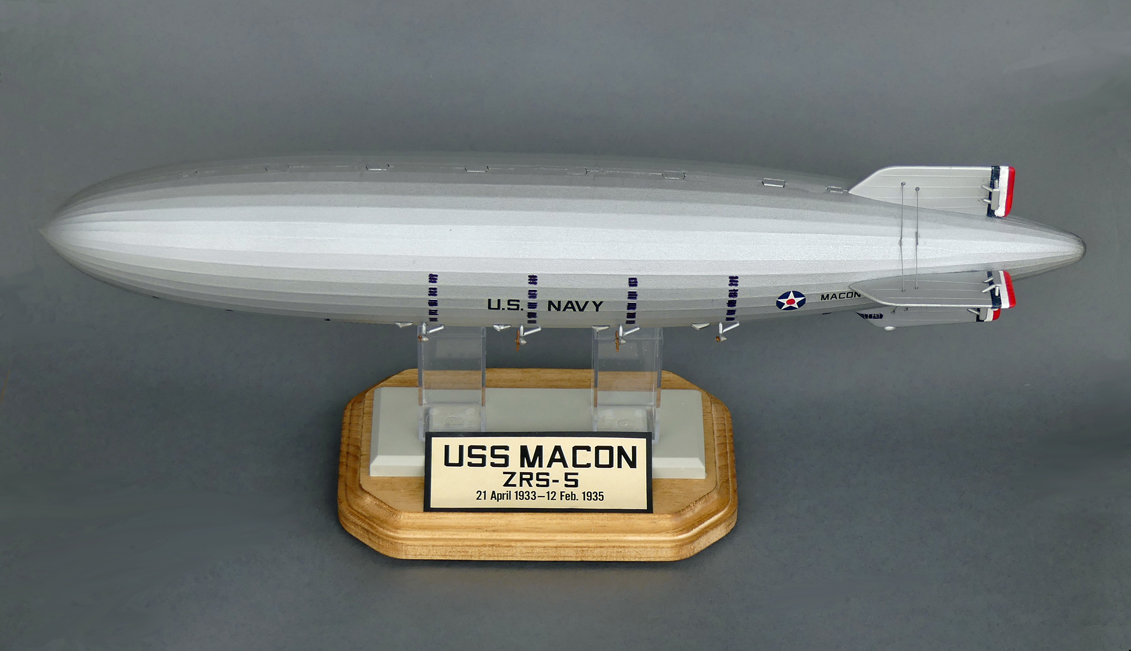

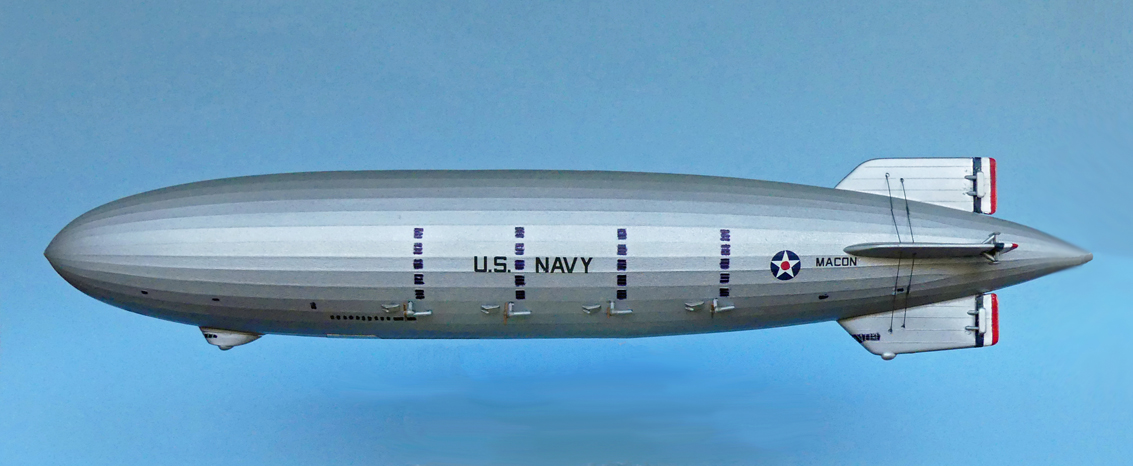

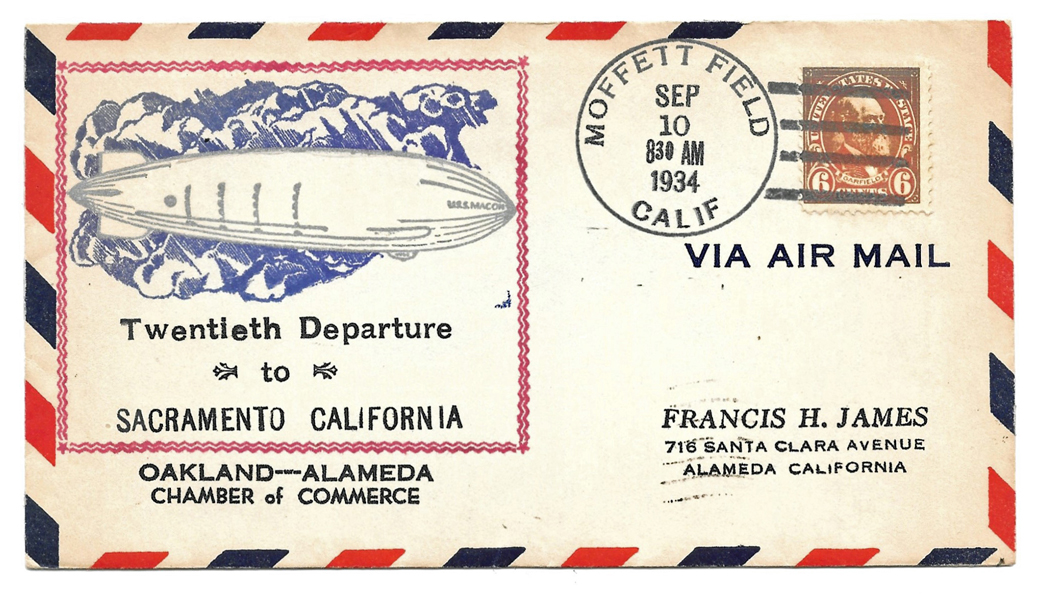
Commemorative cover from my collection.